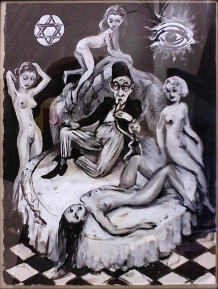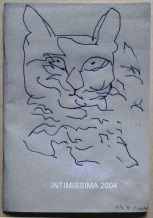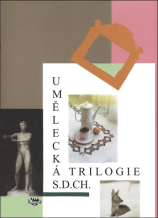| Revista Umělec 2005/2 >> Björn Melhus | Lista de todas las ediciones | ||||||||||||
|
|||||||||||||
Björn MelhusRevista Umělec 2005/201.02.2005 Spunk Seipel | revolutionary DIY | en cs de |
|||||||||||||
|
War provides us with many images, duly generated by the media. In the last 15 years, however, one institution more than any other has put its stamp on our collective consciences with respect to images of war, namely, the Pentagon. And thus the US Defense Department took precautions in the Second Gulf War that the war itself could be summed up as little more than all those people who in fact weren't bombed out of their homes during the assault, along with some generic, harmless-looking night shots of Bagdad under attack. Oh yes, in Operation Iraqi Freedom, the Pentagon made sure to supply us all with imagery much different than in wars previous. Journalists were allowed to march alongside the troops during their advance—and in so doing, were robbed of their objectivity. The war became a staged event for those who were not directly affected by it, divied up into different roles, playing out a script that could well have come straight out of Hollywood.
How Should Artists Deal with Such Things? At the Kunstmuseum in Stuttgart, video artist Björn Melhus is currently providing an impressive answer to this question with his video installation Still Men Out There. In a darkened space, three circles, each consisting of five monitors, are arranged, with a sixth in the center. Melhus, who in the meantime has become quite well-known for portraying the roles of all characters in his films and videos, declines to use any ‘pictures’ in this one. Instead, an impressive sound collage comprised of original quotes by members of the government and actors from Hollywood movies are backed by the pseudo-heroic music of the crusades and ‘illustrated’ with the various monochrome colors of the monitors. The basic premise: If one can no longer trust any image of war to be authentic, then the only solution must be the complete renunciation of all imagery whatsoever in order to truly demonstrate the real tragedy of war. Melhus succeeds in doing this with a haunting work of art that is deeply moving. At the same time, he not only alludes to individual suffering but, much more importantly for him, effectively launches a critique of the theatricality of the war and the media machine that the Pentagon (with the assistance of certain Hollywood supporters) has so perfectly orchestrated. Melhus does this so well that at a certain point we are really unable to differentiate which material is original, taken directly from the war, and what is simply drawn from moviemaking. But that, after all, is indeed one of the greatest things that Berlin resident Björn Melhus (born 1966), a prolific video artist who studied in Braunschweig and spent several years in the US on fellowships, manages to inspire in observers: an emotional reaction paired with intellectual criticism of the creations of an Americanized media culture. In so doing, Melhus doesn’t simply regard himself as an objective observer, but rather as a part of a generation that grew up with television and has indelibly been affected by the medium. Flipper, Lassie, Black Beauty, the Smurfs and cowboys were the childhood heroes of his generation. Later, the day-time talk shows from the USA arrived and, of course, the televangelist, faith-based shows. All are featured in the videos, sometimes as a video collage, but mostly in scenes that he himself plays out on screen. In this way, Melhus is reflecting our viewing habits and our culture, which in his opinion have been shaped to a great extent by the TV consumer. But the artist also takes a strongly critical stance on the medium that has had such a great influence in our daily lives. He notes with great apprehension how German soap operas have yet again ushered in the conservative view of the role of women in society in a way that would have seemed laughable ten years ago. Similar to the media’s manipulation of public opinion about the war, resistance and protest in German society has remained practically non-existent. Melhus has developed his own particular individual style to address these themes. Ever since his video Das Zauberglas (The Magic Mirror) was released in 1991, which features a love relationship unfolding between a TV junkie and a girl on TV, he has repeatedly used only himself as the actor(s) in his productions. As a matter of course, this has become the trademark by which he is known. Of course using only one person in different roles has been substantially facilitated by the advent of new digital techniques that make arbitrary duplication possible. Citing a virtual twin brother in the credits is certainly a bit redundant, yet producing films in this way does definitely create larger logistical and planning problems than an ‘ordinary’ film might, for Melhus does expend a lot of energy on his depiction of the characters. In elaborate films such as 2003’s Auto Center Drive, a venture for which he had almost a dozen different roles, the shoot had to be precisely coordinated, especially when it came to the hairstyles. For each role, his hair had to be cut and dyed differently. No doubt the fact that Melhus uses only himself as an actor in his productions does indeed tend to lend them something of a comic effect that ultimately makes his work more accessible to viewers. In playing all the parts, Melhus isn’t a simply doing so due to a lack of funds or the conviction that he is the only actor capable of filling his roles; on the contrary, he’s employing an artificial means of duplication and playing on it using repetition and identification with cliches that can then be scrutinized all the more harshly. This is especially obvious in pieces such as Again and Again, made in 1998, a critique of genetic modification. And in the 1995 film Weit Weit Weg (Far Far Away), a new version of the Wizard of Oz in which a second Dorothy living in a dour apartment in a housing development from the 1970s in Germany establishes contact with her double in America using a telephone and a satellite dish. In this video as well as in all others, Melhus plays with our concept of image perceptions as we know them, accomplishing this above all, however, with sound. In most cases, he usually finishes the sound first before shooting the actual scenes for the films. Earlier he liked to experiment with German subtitling of American films, especially because of their artificiality. In the meantime, he has come to use original voices for his accompanying soundtracks that are then enriched with different musical elements. This is not only a tribute to the international reception of his work, but also the result of two longer stays in America and something of a change in his thematic choices. Religious TV shows featuring televangelists still haven’t hit the airwaves in Germany—not yet, anyway. A second important aspect of his films is the above-mentioned use of repetition and the duplication of sound and pictures. This, too, is a play on our TV-watching habits, the media’s manipulation of every occurrence that really seems to penetrate our consciousness through constant repetition on the one hand, and reflects individuals’ inabilities to communicate on the basis of media consumer habits on the other. Melhus continually creates strong, impressive images in his installations and films. In the process, he alternates between films that can be seen on single TV screens or in the cinema and complicated stagings of his works such as Primetime (2001), for example, which can only be experienced in a museum atmosphere, set up on risers and using several dozen video monitors. In a nutshell, without fully distancing himself from it, Melhus is proving himself to be one of the most imaginative critics of the expanding influence of television culture that permeates our daily life today. We’re all children of the TV age, and simple, one-sided critiques, so common in the 70s and 80s, have little effect on us anymore. Certainly not, many of us want to embrace these television images, perhaps be a smurf ourselves for a few hours—while pointing to the Disneyfication of the world as utterly evil at the same time. Melhus is very critical of American politics and consumer culture shows, without falling into the close-minded hatred of America that so many European intellectuals have, and is inclined to be count himself among its vociferous critics, albeit with a certain degree of ambivalence. He is one of the few who have succeed in doing so in his very own, unique way, simultaneously maintaining a balance of both guarded distance and close proximity to the idols of TV culture. In other words, Melhus is successfully making Dorothy into an ironic figure—by identifying with her. And in Stuttgart, with Still Men Out There, Melhus has once again succeeded in connecting the intellectual critique of a propaganda machine with the emotional compassion for the victims of war through a piece of abstract art.
01.02.2005
Artículos recomendados
|
|||||||||||||
|
04.02.2020 10:17
Letošní 50. ročník Art Basel přilákal celkem 93 000 návštěvníků a sběratelů z 80 zemí světa. 290 prémiových galerií představilo umělecká díla od počátku 20. století až po současnost. Hlavní sektor přehlídky, tradičně v prvním patře výstavního prostoru, představil 232 předních galerií z celého světa nabízející umění nejvyšší kvality. Veletrh ukázal vzestupný trend prodeje prostřednictvím galerií jak soukromým sbírkám, tak i institucím. Kromě hlavního veletrhu stály za návštěvu i ty přidružené: Volta, Liste a Photo Basel, k tomu doprovodné programy a výstavy v místních institucích, které kvalitou daleko přesahují hranice města tj. Kunsthalle Basel, Kunstmuseum, Tinguely muzeum nebo Fondation Beyeler.
|






































 New book by I.M.Jirous in English at our online bookshop.
New book by I.M.Jirous in English at our online bookshop.
Comentarios
Actualmente no hay comentariosAgregar nuevo comentario